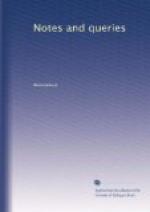“These lives, characters, and moral essays would, I think, fill two or three volumes in 8vo., but they are written in so minute a character, that I cannot form any conjecture to be depended upon.”
I have been thus particular in describing these “histories”, because the subjects of them are identical with those in Fuller’s Holy and Profane State, the first edition of which was published at Cambridge, in 1642. “The characters I have conformed,” says Fuller in his Preface, “to the then standing laws of the realm (a twelvemonth ago were they sent to the press), since which time the wisdom of the King and state hath” altered many things. Nicholas Ferrar died December 2, 1637, and the Query I wish to ask is, Did Fuller compose them (for that he was really the author of them can hardly be doubted) at the suggestion and for the benefit of the community at Gidding, some years before he published them; and is it possible to ascertain and determine if the MS. is in the handwriting of Ferrar or Fuller?
Is there any print or view in existence of the “Nunnery,” at Little Gidding?
In the Life of Dr. Thomas Fuller, published anonymously in 1661, it is stated, that at his funeral a customary sermon was preached by Dr. Hardy, Dean of Rochester, “which hath not yet (though it is hoped and much desired may) passe the presse,” p. 63.
Query. Was this sermon ever published? and secondly, who was the author of the Life from which the above passage is quoted?
John Miland.
* * * * *
STUKELEY’S “STONEHENGE.”
May I request a space in your periodical for the following Queries, drawn from Dr. Stukeley’s Stonehenge and Abury, p. 31.?
1st. “But eternally to be lamented is the loss of that tablet of tin, which was found at this place (Stonehenge) in the time of King Henry VIII., inscribed with many letters, but in so strange a character that neither Sir Thomas Elliott, a learned antiquary, nor Mr. Lilly, master of St. Paul’s school, could make any thing out of it. Mr. Sammes may be right, who judges it to have been Punic. I imagine if we call it Irish we shall not err much. No doubt but what it was a memorial of the founders, wrote by the Druids and had it been preserved till now, would have been an invaluable curiosity.”
Can you or any of your contributors give me any further information about this inscription?
2. The Doctor continues,
“To make the reader some amends for such a loss I have given a specimen of supposed Druid writing, out of Lambecius’ account of the Emperor’s library at Vienna. ’Tis wrote on a very thin plate of gold with a sharp-pointed instrument. It was in an urn found at Vienna, rolled up in several cases of other metal, together with funeral exuviae. It was thought by the curious, one of those epistles which the Celtic




